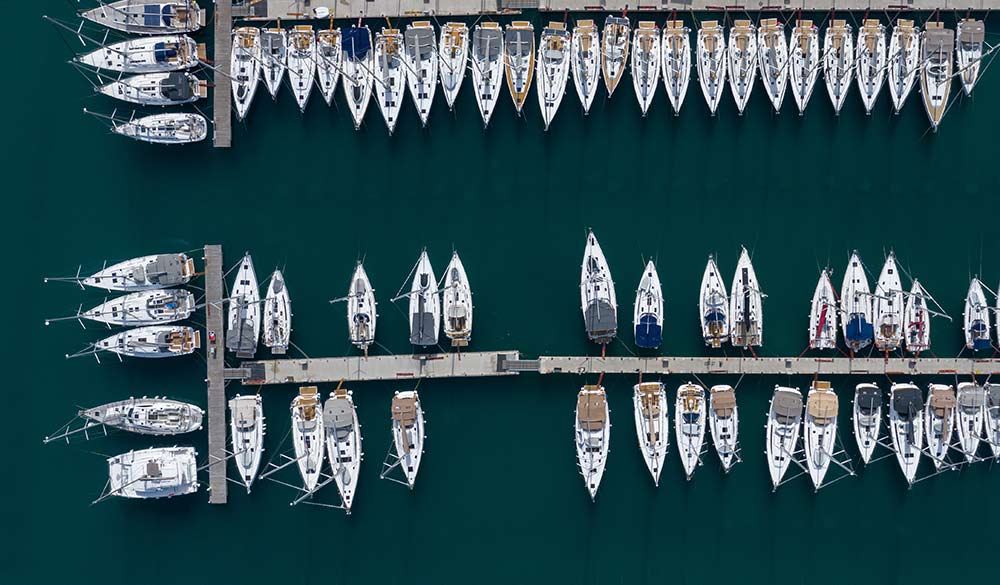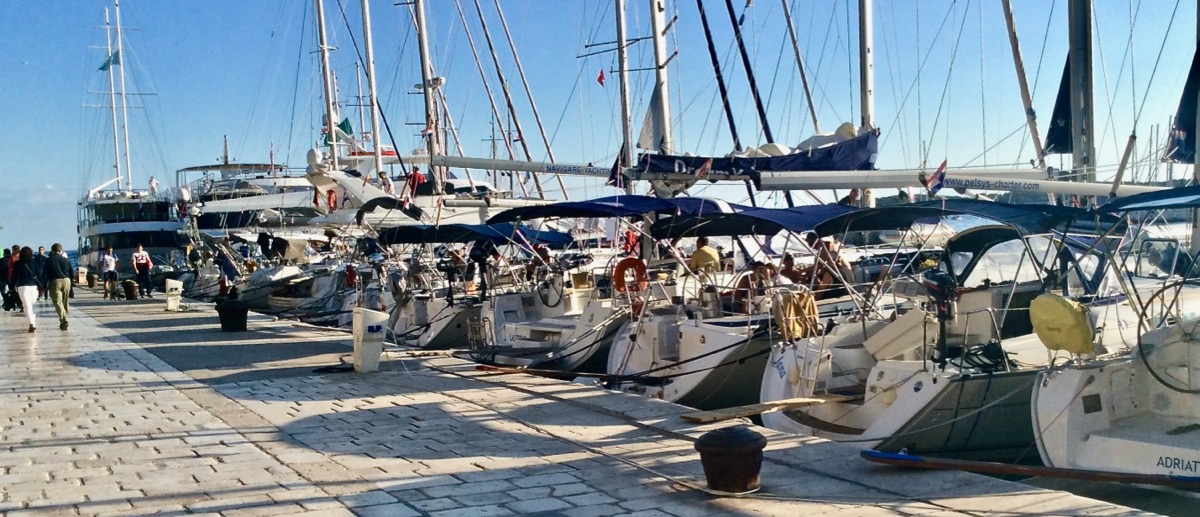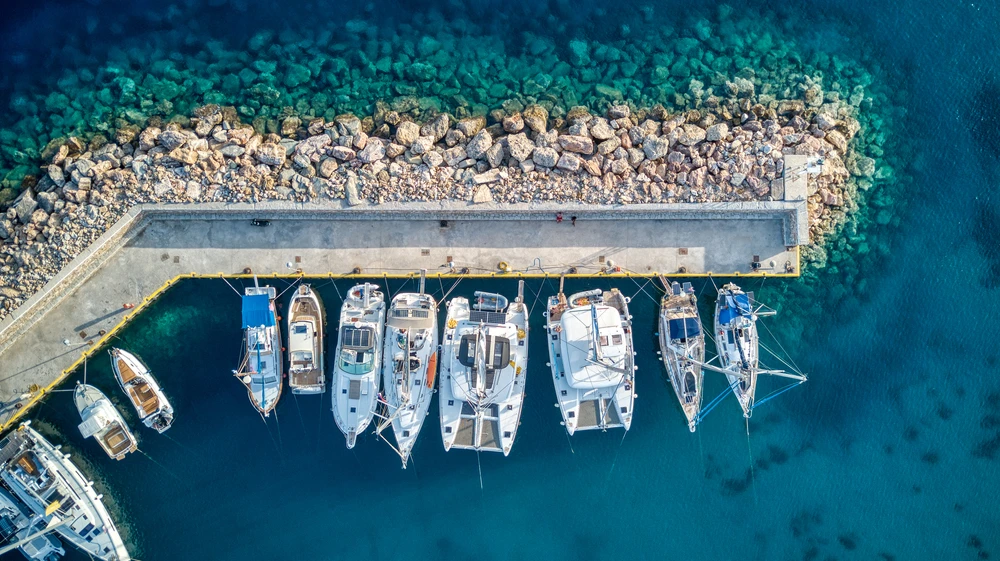Mediterranean Mooring
 There are two main techniques for parking your boat Med style. We can use our anchor or additional bowlines as an alternative to our anchor. Both these methods are designed to keep our boat perpendicular to the quay. There is also a variation to using your anchor. Many marinas have pre-positioned concrete blocks approximately 30 meters from the quay. A “slime line” picked up on the quay is passed forward to the bow, allowing you to tension the slime line (or lazy line) and thereby securing the bow of your boat to the concrete block on the seabed.
Here’s a step-by-step breakdown of the stern mooring with an anchor procedure, also known as Mediterranean mooring:
There are two main techniques for parking your boat Med style. We can use our anchor or additional bowlines as an alternative to our anchor. Both these methods are designed to keep our boat perpendicular to the quay. There is also a variation to using your anchor. Many marinas have pre-positioned concrete blocks approximately 30 meters from the quay. A “slime line” picked up on the quay is passed forward to the bow, allowing you to tension the slime line (or lazy line) and thereby securing the bow of your boat to the concrete block on the seabed.
Here’s a step-by-step breakdown of the stern mooring with an anchor procedure, also known as Mediterranean mooring:
Preparation:
- Do a recce:
If possible, motor past your potential mooring (a few times) to gain an appreciation and situational awareness of what needs to be done.
Identify any issues hindering your approach and plan to overcome them.
If this is your first time, don’t panic. Stay calm and count on all the practice you’ve done before. It may seem chaotic and crazy (well, it is), but you will get used to it.
- Check the method used:
Ensure that other boats are parked using their anchors. If you see the use of lazy lines, also known as “slime lines” (because they spend most of their lives in the water and become slimy), change your plan and use the slime line instead of your anchor. You will use a concrete block already deployed with the slime line attached. The only difference is that you set the appropriate tension on the slime line rather than your rode.
- Anchor and Rode Check:
Ensure that the anchor, anchor chain or rode, and windlass are all in good condition. Also, ensure that the windlass isolation switch is turned on and the windlass is operational.
You’ll need a sufficient length of rode to anchor at a reasonable distance from the quay, often 3 to 5 times the depth of the water, depending on the tide and wind conditions.
- Fenders:
If you have 20 fenders on board, use 20 fenders.
A large round fender for the stern may sometimes come in handy.
Deploy your fenders on both port and starboard.
Did I mention fenders?
- Stern Lines:
Prepare lines for the stern, as these will be used to secure the boat to the quay once the stern is about half to one meter from the quay.
Attach them to your boat’s stern cleats and ensure you run the stern line outside the lifelines or railing, ready to deploy.
- Gangplank:
Most charter boats in the Med have a gangplank, which makes it easier to bridge the gap between your boat and the quay. Ensure you are aware of the length and condition of your gangplank.
- Tide and wind:
The tide in the Mediterranean is unlike the tide in Australia, with some places experiencing a difference of less than 10cm between high and low tide. Nonetheless, always be aware of the tide and its movements. Read more about tides and the rule of 12.
Wind is a significant factor in parking your boat Med style. Anticipate some drift due to wind.

Approaching the Quay:
- Position the Vessel:
Position the vessel so that you are approximately 40 to 50 meters away from the quay.
The bow should face the quay, with sufficient space for the stern to swing toward it.
Make the swing and point the stern towards the quay, slightly pointing upwind if the conditions permit.
Dropping the Anchor:
- Drop the Anchor:
Once in position with your stern facing the quay, drop the anchor, carefully letting the chain or rode out at the same speed as the boat will be reversing. Ensure your anchor rode is never tensioned, but do not drop too much rode as it may get tangled.
Allow enough scope of anchor chain or rode, typically 3-5 times the depth of the water, as the anchor needs to hold the boat securely. The windier the conditions (now and predicted), the more rode.
Reversing the Vessel:
- Reverse to the Dock:
Slowly reverse the boat toward the dock. Maintaining a constant, slow speed is advisable to avoid “prop-walk.” However, you can use prop-walk to your advantage if you have the skills. Remember, no momentum-no control.
My dad used to say, “Don’t approach the dock faster than you are willing to run into it.” Good advice, but momentum is essential!
On a catamaran, lock your steering and utilise your two engines to control your boat. It’s just one thing less to worry about…
Communicate with your anchor helper to let rode out at an appropriate rate.
When near the quay, have your helper move to the stern of the boat in preparation for docking.

Securing the Stern:
- Dock the Stern:
As the stern swings toward the dock, position the boat such that the stern is about 1-2 meters from the quay.
Important: Don’t let the stern swing too far or hit the dock. It should be controlled and parallel to the pier.
- Tie Stern Lines:
Once the boat is in position, securely tie the stern lines (aft lines) to the dock. Start with the windward line so the helmsman can adjust the boat’s angle using forward thrust and helm. PRACTICE!
Many marinas have staff who will help you tie your stern lines. Look out for these kids as they know what they are doing.
Adjusting the Anchor Rode:
- Tensioning your anchor rode:
After securing the stern, tension the anchor rode. Your rode should be around 45 degrees (as in much tighter than your typical anchoring). See regular anchoring techniques.
Important: The anchor (in conjunction with your stern lines) should hold the boat in place without allowing it to drift side to side, backwards, or forwards.
Final Adjustments:
- Tighten the Mooring Lines:
Readjust both the stern lines once you are confident the boat is in place and will not drift.
Ensure you can step off or the distance is right for a gangplank.
Tightening your sternlines to manoeuvre the boat closer to the quay must be done while simultaneously loosening the anchor rode.
Monitoring the Mooring:
- Watch and Act:
Periodically check if the anchor is holding and your rode is nice and taut.
- Weather Changes:
Be aware of any changes in wind or current that may affect the boat’s holding.
Key Points:
- When in Rome: determine if the anchor method is used at the local quay. If not, don’t use it! Use the slime line provided.
- Communication: Have pre-determined hand signals between the helmsman and the first mate. These places are often noisy.
- Anchor Placement: Not too far as other boats may run into your rode. Not too close, as the anchor may not set. You need to practice this and gain experience.
- Controlled Reversal: Reversing toward the quay needs to be done carefully, with close attention to the bow and stern, as you don’t want to hit the quay or other vessels. Fenders galore…
- Use of stern Lines: These lines help control the boat’s position, and if necessary, can pull the boat into the quay once the anchor is set.
Med Mooring - oh, the serenity...

NAVIGATION RULES CLINIC + BASIC SAIL TRIM COURSE
Author
-

Rene is a keelboat instructor and sailing coach in the Mandurah area WA. He is also the author of several books about sailing including "The Book of Maritime Idioms" and "Renaming your boat".
View all posts


